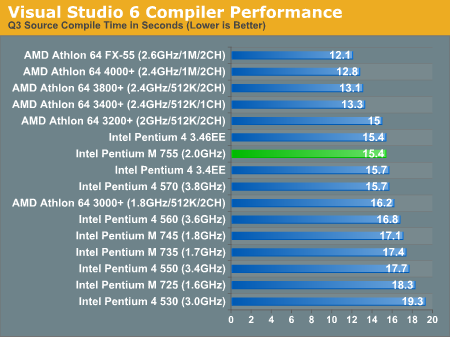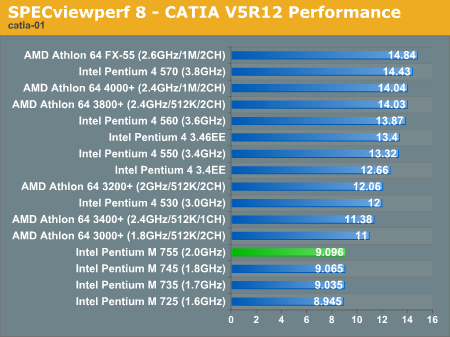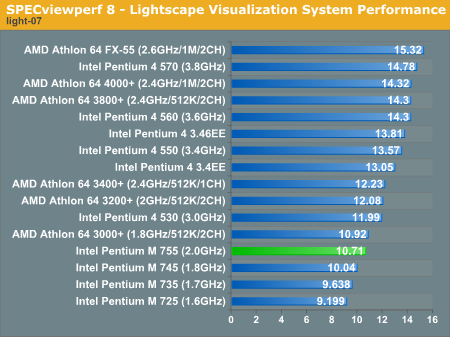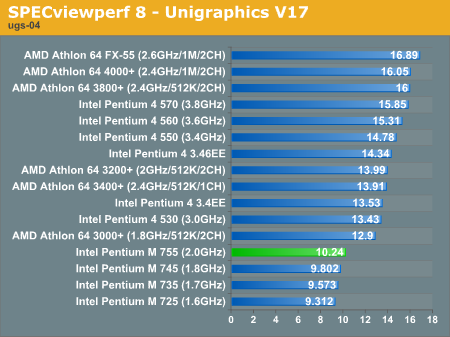Intel's Pentium M on the Desktop - A Viable Alternative?
by Anand Lal Shimpi on February 7, 2005 4:00 PM EST- Posted in
- CPUs
Workstation Applications
Visual Studio 6
Carried over from our previous CPU reviews, we continue to use Visual Studio 6 for a quick compile test. We are still using the Quake 3 source code as our test and measure compile time in seconds.
The Pentium M is very competitive with the Pentium 4 in our compiler test, but still not enough to compete with the Athlon 64.
SPECviewperf 8
For our next set of professional application benchmarks, we turn to SPECviewperf 8. SPECviewperf is a collection of application traces taken from some of the most popular professional applications, and compiled together in a single set of benchmarks used to estimate performance in the various applications that the benchmark is used to model. With version 8, SPEC has significantly improved the quality of the benchmark, making it even more of a real world indicator of performance.We have included SPEC's official description of each one of the 8 tests in the suite.
As you can guess, with the majority of performance in 3D workstation applications being determined by floating point performance and memory bandwidth, the Pentium M doesn't fare too well:
3dsmax Viewset (3dsmax-03)
"The 3dsmax-03 viewset was created from traces of the graphics workload generated by 3ds max 3.1. To ensure a common comparison point, the OpenGL plug-in driver from Discreet was used during tracing.
The models for this viewset came from the SPECapc 3ds max 3.1 benchmark. Each model was measured with two different lighting models to reflect a range of potential 3ds max users. The high-complexity model uses five to seven positional lights as defined by the SPECapc benchmark and reflects how a high-end user would work with 3ds max. The medium-complexity lighting models use two positional lights, a more common lighting environment.
The viewset is based on a trace of the running application and includes all the state changes found during normal 3ds max operation. Immediate-mode OpenGL calls are used to transfer data to the graphics subsystem."

CATIA Viewset (catia-01)
"The catia-01 viewset was created from traces of the graphics workload generated by the CATIATM V5R12 application from Dassault Systems.
Three models are measured using various modes in CATIA. Phil Harris of LionHeart Solutions, developer of CATBench2003, supplied SPEC/GPC with the models used to measure the CATIA application. The models are courtesy of CATBench2003 and CATIA Community.
The car model contains more than two million points. SPECviewperf replicates the geometry represented by the smaller engine block and submarine models to increase complexity and decrease frame rates. After replication, these models contain 1.2 million vertices (engine block) and 1.8 million vertices (submarine).
State changes as made by the application are included throughout the rendering of the model, including matrix, material, light and line-stipple changes. All state changes are derived from a trace of the running application. The state changes put considerably more stress on graphics subsystems than the simple geometry dumps found in older SPECviewperf viewsets.
Mirroring the application, draw arrays are used for some tests and immediate mode used for others."

Lightscape Viewset (light-07)
"The light-07 viewset was created from traces of the graphics workload generated by the Lightscape Visualization System from Discreet Logic. Lightscape combines proprietary radiosity algorithms with a physically based lighting interface.
The most significant feature of Lightscape is its ability to simulate global illumination effects accurately by precalculating the diffuse energy distribution in an environment and storing the lighting distribution as part of the 3D model. The resulting lighting "mesh" can then be rapidly displayed."

Maya Viewset (maya-01)
"The maya-01 viewset was created from traces of the graphics workload generated by the Maya V5 application from Alias.
The models used in the tests were contributed by artists at NVIDIA. Various modes in the Maya application are measured.
State changes as made by the application are included throughout the rendering of the model, including matrix, material, light and line-stipple changes. All state changes are derived from a trace of the running application. The state changes put considerably more stress on graphics subsystems than the simple geometry dumps found in older viewsets.
As in the Maya V5 application, array element is used to transfer data through the OpenGL API."

Pro/ENGINEER (proe-03)
"The proe-03 viewset was created from traces of the graphics workload generated by the Pro/ENGINEER 2001TM application from PTC.
Two models and three rendering modes are measured during the test. PTC contributed the models to SPEC for use in measurement of the Pro/ENGINEER application. The first of the models, the PTC World Car, represents a large-model workload composed of 3.9 to 5.9 million vertices. This model is measured in shaded, hidden-line removal, and wireframe modes. The wireframe workloads are measured both in normal and antialiased mode. The second model is a copier. It is a medium-sized model made up of 485,000 to 1.6 million vertices. Shaded and hidden-line-removal modes were measured for this model.
This viewset includes state changes as made by the application throughout the rendering of the model, including matrix, material, light and line-stipple changes. The PTC World Car shaded frames include more than 100MB of state and vertex information per frame. All state changes are derived from a trace of the running application. The state changes put considerably more stress on graphics subsystems than the simple geometry dumps found in older viewsets.
Mirroring the application, draw arrays are used for the shaded tests and immediate mode is used for the wireframe. The gradient background used by the Pro/E application is also included to better model the application workload."

SolidWorks Viewset (sw-01)
"The sw-01 viewset was created from traces of the graphics workload generated by the Solidworks 2004 application from Dassault Systemes.
The model and workloads used were contributed by Solidworks as part of the SPECapc for SolidWorks 2004 benchmark.
State changes as made by the application are included throughout the rendering of the model, including matrix, material, light and line-stipple changes. All state changes are derived from a trace of the running application. The state changes put considerably more stress on graphics subsystems than the simple geometry dumps found in older viewsets.
Mirroring the application, draw arrays are used for some tests and immediate mode used for others."

Unigraphics (ugs-04)
"The ugs-04 viewset was created from traces of the graphics workload generated by Unigraphics V17.
The engine model used was taken from the SPECapc for Unigraphics V17 application benchmark. Three rendering modes are measured -- shaded, shaded with transparency, and wireframe. The wireframe workloads are measured both in normal and anti-alised mode. All tests are repeated twice, rotating once in the center of the screen and then moving about the frame to measure clipping performance.
The viewset is based on a trace of the running application and includes all the state changes found during normal Unigraphics operation. As with the application, OpenGL display lists are used to transfer data to the graphics subsystem. Thousands of display lists of varying sizes go into generating each frame of the model.
To increase model size and complexity, SPECviewperf 8.0 replicates the model two times more than the previous ugs-03 test."











77 Comments
View All Comments
bluesdoggy - Tuesday, February 8, 2005 - link
...in the mobile world, the Pentium 4 and Athlon 64 are often castrated or limited either by low clock speeds...Mommy, is that processor a steer?
valnar - Tuesday, February 8, 2005 - link
As usual, an unfair review. Comparing a 2.0Ghz 400FSB laptop CPU against 3.0Ghz desktop heatmonsters? Of course it won't beat them. But look at how well it does, and probably would do (if reviewed correctly) against Pentium 4 2.4-2.8Ghz CPU's. Considering the ultralow power it needs and lack of heat it generates, this WILL be the hot (err... cool) ticket for Shuttle XPC's and the like in the near future. For anyone who doesn't need the fastest processor at the moment, the Banias designers did a fantastic job.EODetroit - Tuesday, February 8, 2005 - link
Great article, its about time that you did this one. And you compared both P-M motherboards on the market, I don't remember the other web sites doing that.You stated that the P-M won't scale, and that's the reason this isn't Intel's desktop future. One thing though... Intel's other desktop CPUs aren't going to scale much this year either. In fact, on a percentage basis, the P-M might actually scale more this year than the various P4-Kiln edition CPUs after all.
Combine that with a mobile-915 chipset for the desktop, and therefore the elimination of the huge memory bottlenecks (and hopefully a little more voltage adjustments) and all of the sudden we may see all those Losses and Ties turn into Ties and Wins.
Whatever happens, don't be the last enthusiast site to review the mobile-915 desktop motherboards when they arrive, like you were with this. We need a trusted source to know what to buy.
mickyb - Tuesday, February 8, 2005 - link
The performance per watt is awesome. Great for SFF. The article is good, but until there is a newer chipset for this CPU, we won't be able to determine a final performance ruling. I am dissappointed in the lack of desktop MB offerings. This will be the challenger to the MAC mini in near future. Someone will be putting laptop components in a box and call it done.I found a couple of things interesting. Taking the memory out of play, it seems the A64 is still better optimized. L1 cache of Northwood is pretty impressive. AMD has an opportunity to improve performance just by improving the L2 cache latency.
I really don't think the Pentium-M limits are around 2.6 GHz by the end of the year. At 22W, this could probably reach higher speeds. I think the upper limit that Intel is publishing is in context of a laptop and the cooling challenges in that platform. If you put a chip in a DT, then it is a different story.
AtaStrumf - Tuesday, February 8, 2005 - link
A great article! Another Anand classic :-)I'd just like you to add an Athlon XP 3200 to the lineup and at least one more Newcastle (which is just the most popular A64 at the moment ;-) May I suggest a 3000+ 2,0 GHz/512/1CH? With just one dot on the graph extrapolating anything becomes a nightmare :-(
As for P-M it's one hell of a CPU considering it's limitations and we just can't stop wondering what it could become if Intel decided to remove them. Sonoma will party answer that question, but unfortunately the ultra low voltage cap will still remain, so we may never really know.
On the other hand I think an A64 will still be a nice enough desktop CPU so we really have no need for P-M on the desktop side of things. With Lancaster-Turion supposedly on S754 we may be in for a very nice successor to 2500+ Mobile, so to hell with P-M >;-)
bob661 - Tuesday, February 8, 2005 - link
C'mon guys. These tests aren't showing that the P-M is crap, just not what we originally thought it was. I am surprised as hell at these results. For a laptop CPU, it still kicks ass. And with two A64 and three AXP machines, I am no Intel fanboy.paulsiu - Tuesday, February 8, 2005 - link
For folks who want to have a mobile chip lower power solution, why not just go to the mobile Athlon 64? The CPU performance should be about the same as their desktop counterpart (at least the socket 754 version) and you can often use the same motherboard as the desktop.The Pentium Mobile idea seems nice, but I can't imagine spending $300 on a board that contains outdated technology.
MIDIman - Tuesday, February 8, 2005 - link
Superb article.Granted, this is a "desktop" review, but I think the P-M is a completely different world from the P4-775 and A64, and I'm not entiely sure how people can compare them. This was built to be a portable solution and has been moved to desktop. Put that into account, and you have an extremely capable system that is silent, passive, and can be extremely small (matx here, but ITX is out there). I'm just trying to figure out why I didn't just read a Sonoma-based review, since it is out and being made (i.e. Dell's new 6000 laptop), or at least a 2.2ghz Dothan.
I think Sonoma will bridge a bit of this performance gap, but consdering that these types of chipsets and CPUs will always be low voltage, I think we'll always see places where its performance is maybe not up to par, but well worth every penny for small and silent with desktop performance. THey'll only get smaller and faster, and IMHO, this is pretty damn close to desktop performance.
muddocktor - Tuesday, February 8, 2005 - link
I agree withpost #36 about the benchmarks seemingly being picked to go for the P-M's weaknesses, but I guess that's how you get article hits. ;) I do fully agree that the present motherboards and chipsets they use hold back the perfromnace quite a bit; it might be a different story when the new mobile 915 chipset mATX boards come out for desktop use though.One glaring weakness in this comprehensive test though is the utter lack of numbers on system power usage and noise. If I were deploying a whole bunch of new systems for a corporation, I would give serious thought to a P-M setup even though the initial outlay would be more than a comparable P4 setup due to the decreased wattage used by the P-M system and the resultant heat from operation being much less, leading to lower environmental costs. Face it, in typical office applications the P-M is more than powerful enough for 90% of the users for the forseeable future and if your company has hundred or thousands of computers, the power saving should more than compensate for the higher pricetag of aquiring the P-M systems.
Anand, when the new mobos based on the mobile 915 chipset come out, you need to revisit Dothan and it's performance.
msva124 - Tuesday, February 8, 2005 - link
What were people expecting out of the pentium m? I have always multiplied the Mhz by 1.5 and used that number as the speed rating. So for instance the 2.0Ghz Dothan would be 3000+. The benchmarks confirm this - with the exception of one or two tests, it met or exceeded the performance of the Athlon 64 3000+.Whenever it was discussed as a desktop alternative I always assumed the implication was that this would be way off in the future, once clock speeds were ramped up.